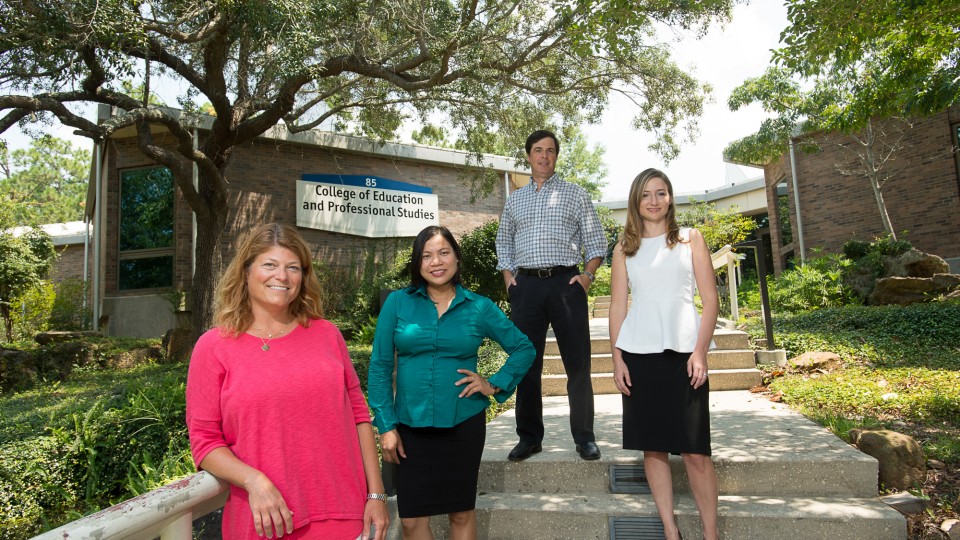The art of student evaluation
- August 13, 2015
- / Kaija Wilkinson
- / education

From left, Melanie DiLoreto, Giang Nguyen-Nguyen, Steve Kass and Valerie Morganson at the University of West Florida. Michael Spooneybarger/ Studer Community Institute
“Beauty is in the eye of the beholder” is a lovely proverb.
But in the world of education testing and evaluation, measuring progress in physical education, visual and performing arts, that platitude won’t make the grade.
However, a team of researchers from the University of West Florida have for the last two years being studying the best way to assess student progress in hard to measure subjects.
Fueled by a $500,000 grant from the U.S. Department of Education’s $4.35 billion Race to the Top fund, the team’s final recommendations were filed with the Florida Department of Education at the end of July.
The researchers cast a wide net, distilling information from books, interviews and brainstorming sessions into key findings. Ten UWF students also helped in the process, conducting interviews with educators in all 50 states and the District of Columbia, recording survey data, reviewing literature and summarizing findings.
Steve Kass, the principal investigator, says the team found that student assessment in visual art, music and physical education should take a three-pronged approach, encompassing:
- Content knowledge (objective testing)
- Affect for the discipline (self-reflection)
- Performance (e.g., playing the correct notes in a musical composition)
Researchers recommend teachers keep portfolios of “student artifacts,” including video or audio recordings, artwork, log-book entries, exercise plans and peer assessments. A subset of items, measured using a common set of scoring tools are then extracted from the portfolio to track improvement.
The state Department of Education will determine how the research is applied.
“Although we have made some very specific recommendations for the state to follow, we currently provide only examples of possible materials that could be used,” Kass said. “We hope that the state will develop the assignments, rubrics and recording methods to accomplish (accurate) assessment of student growth.”
The UWF research team
In addition to Steve Kass and the students, the UWF research team was:
- Melanie DiLoreto, teacher education and educational leadership.
- Giang-Nguyen Nguyen, teacher education and educational leadership.
- Valerie Morganson, psychology.
- Richard Glaze for music education.
- Danny Drost for physical education.
- Julie Gray for educational administration.
- Sandra Durr, a retired educator of the arts.
How they did it
Launched in January 2014, phase one of the research consisted of the phone and email surveys and interviews with DOE officials from throughout the U.S. to learn how they were assessing progress in the hard-to-measure areas.
Researchers also searched the literature to identify empirically-tested practices.
“From this, we identified some best practices,” Kass said.
For example, it was generally agreed that a student’s painting or musical performance may be evaluated by subject-matter experts using rubrics, and a student’s knowledge about specific subject area content could be more easily evaluated using quantitative measures.
The research found that some states consider visual and performing arts core curricula, but many states do not require schools to assess the performance of students in these disciplines. While methods differ, performing and visual arts are widely regarded as “learning-by-doing” activities.
Why measuring the arts matters
In an April 2014 report, “Student Growth Models for Hard-to-Measure Course Content Areas: A Review of the Literature, Survey of U.S. Practices and Recommendations,” researchers note that some states, such as Maryland, integrate art assessment into other, core academic areas.
“Examples include utilizing vocabulary words to describe a piece of music or visual art, or illustrating the significance of a piece in relation to the culture and historical context in which it was created,” the report states.
Linking core subjects like languages arts and social studies to visual or performing arts can be motivational tool for students, helping them see how math or language arts applies to art or music for example.
Assessing student progress is critical, the researchers contend, because it prompts students to reflect on what they have learned, on their strengths and weaknesses, and it provides information teachers can use to modify instruction as appropriate.
At the policy and political level, assessment results often are used to make decisions about funding.
Failure to assess music, visual art and physical education while assessing subjects such as math and English, Morganson said, encourages the perception that the hard-to-assess subjects are irrelevant.
“In this regard,” she said, “accurate assessment might be viewed as a valuable tool for demonstrating utility, which is essential in today’s day and age.”
Effective assessment tools can help establish objective measures of what students should get out of the classes.
DiLoerto said national professional organizations can help by recommending benchmarks for student achievement in their respective disciplines.
Kass expects the final reports to be published online and hopes administrators and teachers take the time to read it.
 CivicCon launches with a look at good growth in cities
CivicCon launches with a look at good growth in cities
 Building stronger brains one baby, one parent at a time
Building stronger brains one baby, one parent at a time
 SCI debuts commercial on Early Learning City
SCI debuts commercial on Early Learning City
 Entrecon: World class speakers and an opportunity to sharpen skills
Entrecon: World class speakers and an opportunity to sharpen skills
 PYP Quality of Life survey 2017
PYP Quality of Life survey 2017
 EntreCon Pensacola 2016: A look back
EntreCon Pensacola 2016: A look back
 Leadership tip: getting better employee takeaways
Leadership tip: getting better employee takeaways
 Leadership tip: be interested instead of interesting
Leadership tip: be interested instead of interesting
 Leadership tip: delivering difficult messages
Leadership tip: delivering difficult messages
 Brain Bags boost Arc, Early Childhood Court programs
Brain Bags boost Arc, Early Childhood Court programs